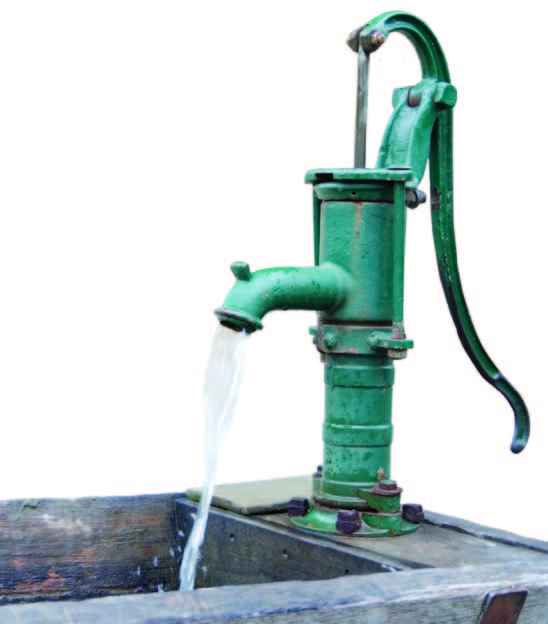The PermaDesign Weblog, with Nate Downey and Melissa McDonald!
Roof-Reliant Landscaping™ Step 18E: Water Distribution - Low-Cost Distribution Alternatives

Above: A hand pump is an old-fashioned device that requires no electricity to operate—just human muscle power.
Low-Cost Distribution Alternatives
The vast majority of roof-reliant landscape designers will choose an electric pump to move water from the cistern to the distribution system. However, if the budget for your roof-reliant landscaping system is tight, here are two low-cost distribution alternatives that you may want to consider:
Hand Pump Systems
Hand pumps are traditional, manually powered devices that lift water often from a relatively shallow depth. Normally, such systems also include a watering can or bucket that gets filled up underneath the hand pump’s spigot. This water is then hauled (or siphoned off) and poured onto the mulch covering the topsoil above the root zones of your plant material.
Hand pumps range in price from under $30 to about $300. Because licensed electricians and plumbers are not required for the installation of a hand-pump system, the actual cost for the installation of such systems is very low.
Hand pumps do not use any electricity, allowing you to eliminate this cost from your monthly expenses. In addition, hand pumps are not complex and therefore the long-term costs of maintenance for such systems are relatively low in comparison to conventional distribution systems.
There are a number of drawbacks associated with hand-pump, or manually powered, systems. For most people, the amount of time and physical energy necessary to pump and distribute harvested water throughout any given landscape is too much work. It is also not practical to connect a hand pump to a drip irrigation system.
Pump-Free Systems
The pump-free alternative is an option that only works in rare circumstances. Your property will need a sufficient slope and a landscape designed specifically for watering to occur using the force of gravity.
For every foot of increased elevation, the pressure in an irrigation tube increases by 0.433 PSI. The minimum pressure for drip irrigation to function properly is between 10 and 15 PSI, which means your plants need to be 25 to 35 feet below your cistern for gravity-fed drip irrigation to function as per the manufacturer’s recommendations.
Just as you cannot have a pump-free system without the proper site, you can’t have a pumpfree system without the right person to run it. Pump-free systems take patience, a good memory and the ability to be available for a number of brief moments of time throughout the property’s watering cycle.
03/04/2016 | (0) Comments










Comments